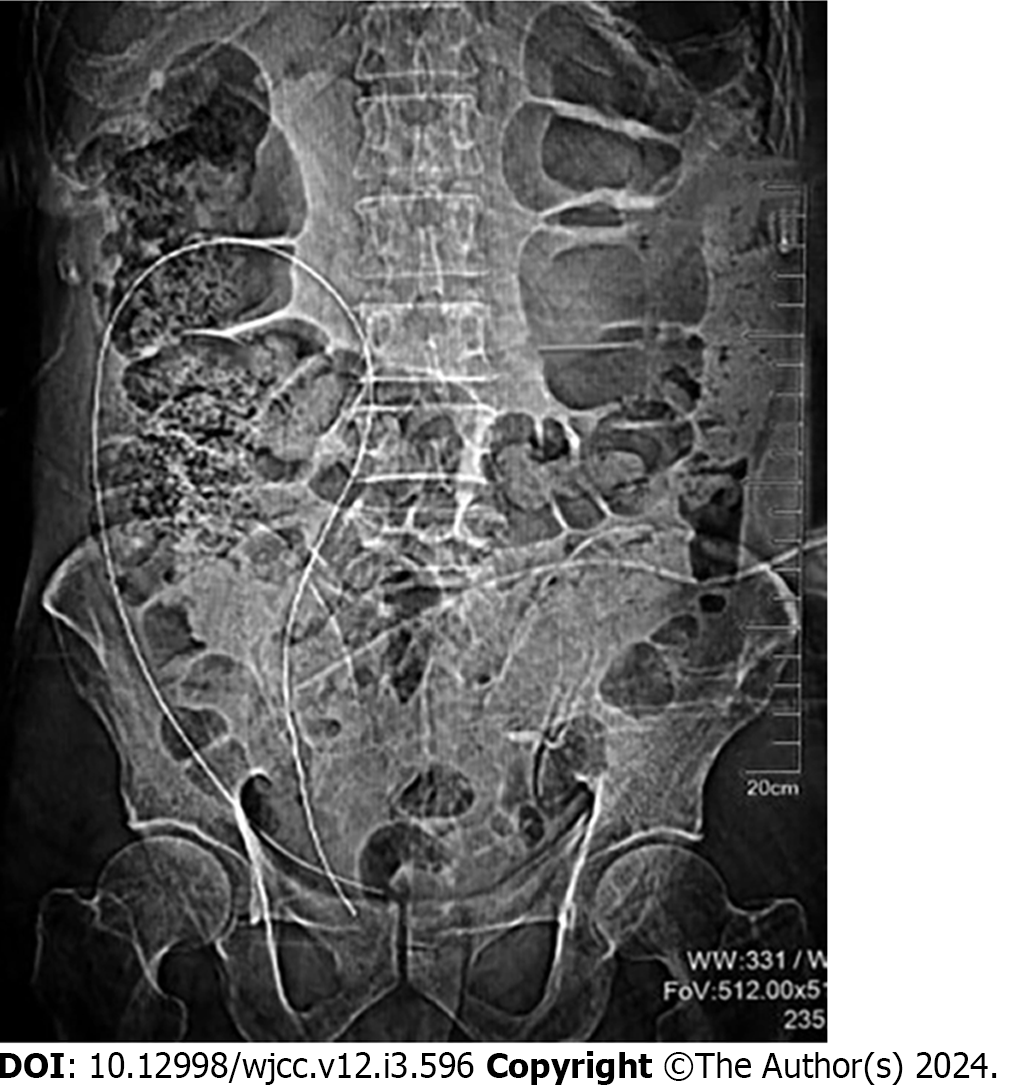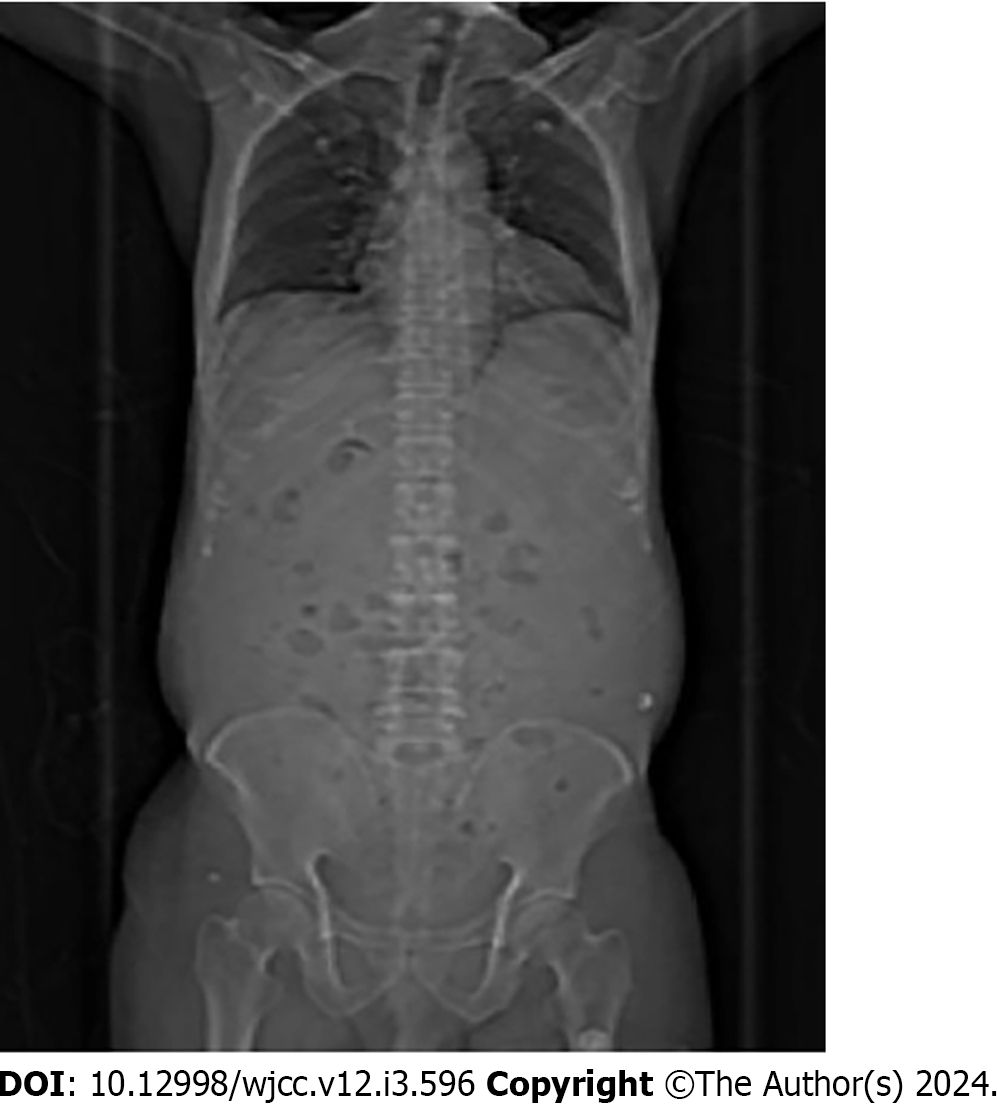Published online Jan 26, 2024. doi: 10.12998/wjcc.v12.i3.596
Peer-review started: October 3, 2023
First decision: December 6, 2023
Revised: December 16, 2023
Accepted: January 4, 2024
Article in press: January 4, 2024
Published online: January 26, 2024
Guidewire slippage into the peritoneal cavity during clinical operations is extremely rare. Therefore, this paper aims to report a successful case of guidewire removal using transgastric natural orifice transluminal endoscopic surgery (NOTES). The goal is to enhance physicians' understanding of the management plan for this unique scenario and provide a valuable reference for clinical practice.
A 64-year-old man presented with abdominal distension and was diagnosed with cirrhosis combined with massive ascites. To proceed with treatment, the patient underwent ultrasound-guided peritoneal puncture and underwent catheterization and drainage. Unfortunately, a 0.035-inch guidewire slipped into the abdominal cavity during the procedure. Following a comprehensive evaluation and consultation by a multidisciplinary team, the guidewire was successfully removed using NOTES.
This case highlights the potential consideration of transgastric NOTES removal when encountering a foreign body, such as a guidewire, within the abdominal cavity.
Core Tip: Guidewires play a crucial role in facilitating various medical procedures. Whereas previous reports primarily focused on guidewire breakage and subsequent entrapment within peripheral blood vessels during interventional procedures, this case highlights a unique incident where a guidewire slipped into the abdominal cavity. After extensive multidisciplinary consultations, which took into account the patient's age, frail physical condition, and fair coagulation function, the abdominal guidewire was successfully removed using natural orifice transluminal endoscopic surgery in accordance with individual wishes of the patient. Consequently, the patient experienced a smooth recovery without fever or abdominal pain. This comprehensive article meticulously delineates the management of this exceptional case, which presents an inevitable scenario in clinical practice, ultimately offering valuable insights for healthcare practitioners.
- Citation: Chen SJ, Zhang DY, Lv YT, Bai FH. Removal of a guide-wire sliding into abdominal cavity via transgastric natural orifice transluminal endoscopic surgery: A case report. World J Clin Cases 2024; 12(3): 596-600
- URL: https://www.wjgnet.com/2307-8960/full/v12/i3/596.htm
- DOI: https://dx.doi.org/10.12998/wjcc.v12.i3.596
Guidewires are pivotal in various clinical procedures, encompassing guidance, support, and exchange. While the retention of guidewires within the body is typically deemed uncommon, recent estimates suggest that, on average, two instances of guidewire retention during central venous catheter insertion arise each month[1]. Nevertheless, only one case involving the retention of guidewires within the abdominal cavity has been previously documented[2]. This article presents the pioneering retrieval of abdominal guidewires utilizing a gastrointestinal natural-tunnel endoscopic procedure (natural orifice transluminal endoscopic surgery, NOTES), thus providing clinicians with a valuable point of reference.
A 64-year-old male patient reported that the guide wire had slipped into the abdominal cavity for 2 d.
The patient, a 64-year-old male, was admitted to the hospital due to abdominal distension. A diagnosis of cirrhosis with extensive ascites was established. To proceed with treatment, the patient underwent ultrasound-guided peritoneal puncture and underwent catheterization and drainage. Unfortunately, a 0.035-inch guidewire inadvertently entered the patient's abdominal cavity during the procedure. Notably, the patient did not experience significant discomfort at the time, and following effective communication, he exhibited understanding and willingness to undergo surgery for the removal of the foreign object.
The patient had been diagnosed with viral hepatitis B for three years and had been consistently receiving entecavir antiviral therapy. Additionally, the patient had been diagnosed with diabetes mellitus for the same duration; however, there had been no regular adherence to medication or monitoring of blood glucose levels, thus rendering the control of blood glucose unknown.
The patient's personal and familial medical history did not reveal any notable or significant findings.
The patient exhibited normal vital signs, while the abdominal examination revealed distension and a slight sensation of pressure in the upper right quadrant without any indication of rebound pain.
The blood tests revealed the following results: white blood cell count of 9.12 × 109, platelet count of 91 × 109, and hemoglobin level of 84 g/L. In terms of liver function, alanine aminotransferase measured 46 U/L, aspartate aminotransferase measured 43 U/L, total bilirubin measured 67.3 μmol/L, and prothrombin time registered at 15.6 s. Renal function and electrolyte tests demonstrated normal results.
The abdominal X-ray examination revealed the presence of elongated dense shadows, prominently visible in the middle and lower right abdomen, extending into the pelvic region (Figure 1).
The object found within the abdominal cavity was identified as a guidewire, which was presumed to have inadvertently entered during peritoneal puncture placement.
Considering the patient's advanced age and deteriorating health condition, the decision was made to remove the guidewire through transgastric NOTES. The procedure was conducted under anesthesia and involved the following steps (Figure 2 and Video): (1) An incision was created in the anterior wall of the gastric antrum using a DualKnife and IT-knife; (2) Exploration of the abdominal cavity allowed for the identification and extraction of the guidewire with the assistance of foreign body forceps through the gastric wall incision; and (3) The wound was treated using thermocoagulation forceps, and the gastric wall incision was subsequently closed with endoclips.
Following the procedure, the patient did not experience any episodes of abdominal pain, fever, or other discomfort. A subsequent abdomen X-ray displayed no dense shadows within the abdominal cavity (Figure 3). The patient was discharged after one-week post-procedure, and during the one-year follow-up period, the patient remained in good health with no complaints of recurrent abdominal discomfort.
The concept of endoscopic laparotomy utilizing the natural lumen was initially introduced by Kalloo et al[3] in the United States in 1998. Subsequently, in 2004, successful transgastric endoscopic cholecystectomy procedures were performed on pigs. In 2005, the American Society for Gastrointestinal Endoscopy and the Society of American Gastrointestinal Endoscopic Surgeons collaborated to propose the notion of NOTES, which has gained widespread adoption since its inception[4]. NOTES represents an evolving minimally invasive technique aimed at mitigating abdominal trauma and its associated complications[5]. When compared to conventional and laparoscopic surgeries, NOTES offers several advantages, including minimal scarring, reduced trauma, diminished pain, shorter surgical pathways, and accelerated healing[4,6].
With the advancement of various interventional therapies, adverse events caused by auxiliary devices like guide wires, guide catheters, and PEG tubes have become increasingly evident. The safe and swift removal of foreign bodies assumes particular significance. Previous reports of guidewire retention predominantly arise from instances where a broken guidewire inadvertently slipped into the bloodstream during procedures such as coronary angiography[1,7]. Unlike those reported cases, the guidewire in the present study was inadvertently left within the abdominal cavity, with only one similar case reported in the literature[2]. In that previous case, the guidewire was retrieved using ultrasound-guided gastroscopic foreign body forceps via a transcutaneous route, which proved to be relatively challenging and unsuitable for patients with extensive ascites or complex guidewire locations. Given the patient's advanced age and weakened state, traditional approaches involving laparoscopy or open surgery were deemed inappropriate. Taking into account the patient's favorable coagulation function and platelet count, the multidisciplinary team ultimately decided on the transgastric NOTES approach. This well-established surgical method may serve as a valuable reference for clinical practice.
Guidewire slippage into the abdominal cavity is a rare occurrence in clinical practice. When faced with such circumstances, the safe and efficient extraction of the guidewire becomes a pertinent consideration. This study advocates for the utilization of the transgastric NOTES technique as an advantageous approach for guidewire removal from the abdominal cavity.
Provenance and peer review: Unsolicited article; Externally peer reviewed.
Peer-review model: Single blind
Specialty type: Medicine, research and experimental
Country/Territory of origin: China
Peer-review report’s scientific quality classification
Grade A (Excellent): 0
Grade B (Very good): 0
Grade C (Good): C, C
Grade D (Fair): 0
Grade E (Poor): 0
P-Reviewer: Kumar R, India S-Editor: Gao CC L-Editor: A P-Editor: Chen YX
| 1. | Mariyaselvam MZA, Patel V, Young HE, Blunt MC, Young PJ. Central Venous Catheter Guidewire Retention: Lessons From England's Never Event Database. J Patient Saf. 2022;18:e387-e392. [PubMed] [DOI] [Cited in This Article: ] [Cited by in Crossref: 3] [Cited by in F6Publishing: 2] [Article Influence: 1.0] [Reference Citation Analysis (0)] |
| 2. | Zhu Z, Zhu J, Qiao Z. Ultrasound guidance for the removal of guide-wire sliding into abdominal cavity. Asian J Surg. 2022;45:1484-1486. [PubMed] [DOI] [Cited in This Article: ] [Reference Citation Analysis (0)] |
| 3. | Kalloo AN, Singh VK, Jagannath SB, Niiyama H, Hill SL, Vaughn CA, Magee CA, Kantsevoy SV. Flexible transgastric peritoneoscopy: a novel approach to diagnostic and therapeutic interventions in the peritoneal cavity. Gastrointest Endosc. 2004;60:114-117. [PubMed] [DOI] [Cited in This Article: ] [Cited by in Crossref: 1037] [Cited by in F6Publishing: 878] [Article Influence: 43.9] [Reference Citation Analysis (0)] |
| 4. | Rattner D, Kalloo A; ASGE/SAGES Working Group. ASGE/SAGES Working Group on Natural Orifice Translumenal Endoscopic Surgery. October 2005. Surg Endosc. 2006;20:329-333. [PubMed] [DOI] [Cited in This Article: ] [Cited by in Crossref: 619] [Cited by in F6Publishing: 509] [Article Influence: 28.3] [Reference Citation Analysis (0)] |
| 5. | Liu BR, Cui GX, Zhang XY, Kaur K, Song JT, Si Y, Kong XC. Pure transgastric NOTES ovarian cystectomy: the first human procedure. Endoscopy. 2014;46 Suppl 1 UCTN:E199-E200. [PubMed] [DOI] [Cited in This Article: ] [Cited by in Crossref: 2] [Cited by in F6Publishing: 3] [Article Influence: 0.3] [Reference Citation Analysis (0)] |
| 6. | Wang S, Guan F, Wang F, Wen P. Transgastric natural orifice transluminal endoscopic surgery (NOTES) to remove a foreign body from the abdominal cavity of a 12-year old boy. Endoscopy. 2022;54:E110-E112. [PubMed] [DOI] [Cited in This Article: ] [Reference Citation Analysis (0)] |
| 7. | Xue Y, Dai L, Jiang W, Zhang H. Off-pump coronary artery bypass concomitant with retrieval of broken guide wire stuck in the brachial artery: a case report. BMC Cardiovasc Disord. 2021;21:46. [PubMed] [DOI] [Cited in This Article: ] [Reference Citation Analysis (0)] |











